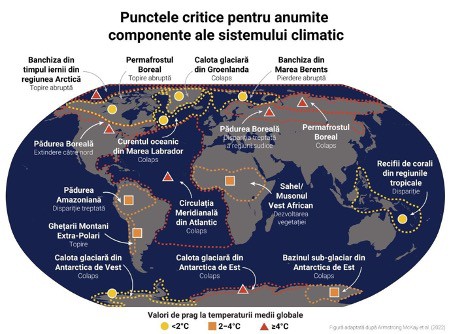In 2022, the global average temperature increased by approximately 1.2°C compared to the pre-industrial period. Based on our everyday life experience, one might think that this wouldn’t make a significant difference.
However, limiting the temperature increase to 1.5°C would substantially reduce the risks and impacts of climate change. But what will happen if the global average temperature continues to rise to values above 2°C? What will be the consequences on a global scale?
Today, we are discussing an average temperature increase for the entire planet, relative to the pre-industrial period. In some regions, the increase will be above average, while in others, it will be lower. However, even a “modest” rise in global average temperature brings about a series of changes, such as an increase in the frequency and intensity of heatwaves.

The evolution of global average temperatures is represented by four observational datasets: HadCRUT, NOAAGlobalTemp, GISTEMP, and Berkeley Earth, as well as two reanalysis datasets, ERA5 and JRA-55. For each dataset, the increase in global average temperature compared to the pre-industrial period (1850–1900) is indicated. There is a strong agreement among these datasets regarding the general trend of global temperature evolution and year-to-year variability. The deviation for the year 2022 is also indicated for each dataset. (The graph can be accessed in an interactive format at http://graphs.climex.ro)
A “small” increase in global average temperature also impacts various elements of Earth’s climatic system. The climatic system is a complex and interactive system composed of five components: the atmosphere (air), hydrosphere (water), cryosphere (ice and permafrost), lithosphere (land surface), and biosphere (living organisms). We can think of the climatic system as being in a state of balance. However, the climatic system is influenced by various external factors such as solar radiation or human activities.
An increase in global average temperature due to human activities can disrupt this state of balance for different components of the climatic system, resulting in an escalation of impact and risk. From this perspective, the 2015 Paris Agreement established a long-term goal of limiting global warming to below 2°C. But what will happen if the global average temperature continues to rise to values exceeding 2°C?
What is the critical point of no return?
A critical point, also known as a tipping point, occurs when a change in a specific component of the climatic system, known as a critical element, becomes self-perpetuating after surpassing a threshold value. This results in significant impacts across extensive regions of the Earth.
Once a critical point is exceeded for certain systems, there is no turning back to the previous state, leading to the emergence of a “new normal.” To better understand what a critical point means in the context of the climatic system, let’s consider the critical point for the West Antarctic Ice Sheet.
As the global average temperature increases, the ice sheet melts. Beyond the critical point, this melting can lead to the collapse of the West Antarctic Ice Sheet. (This article published on the CarbonBrief platform contains a detailed discussion of climatic system tipping points.)
An article published at the end of last year in the journal Science attempts to address these questions. The synthesis of scientific literature in the field starts with the concept of critical points within the climatic system and assesses the probability of surpassing these critical points for various increases in global average temperature compared to the pre-industrial period.
The authors of the study, a team of researchers from the UK, Sweden, and Germany, identified 16 critical elements of the climatic system (compared to eight identified in a 2008 study) with a significant role at the global level (9 critical elements) or the regional level (7 critical elements) (Figure 2).

Tipping Points for Different Components of the Climate System
The study’s findings indicate that five critical points are already possible for current global average temperature values (1.1°C):
- Collapse of the Greenland Ice Sheet: The melting of this ice sheet could lead to a sea level rise of approximately 7 meters, significantly impacting coastal regions. However, this melting process, once initiated, is a prolonged one.
- Collapse of the West Antarctic Ice Sheet: This ice sheet contains enough ice to raise sea levels by about 3 meters, and this is a process that occurs over a large time scale.
- Disappearance of Coral Reefs in Tropical Regions: Elevated temperatures expose corals to thermal stress, leading to their disappearance (“coral bleaching“). The impact here is direct on ecosystems, as well as on tourism and fishing.
- Abrupt Thawing of Permafrost in Northern Regions: With permafrost thawing, carbon dioxide and methane stored in frozen soil are released, leading to increased concentrations of greenhouse gasses.
- Collapse of the Labrador Sea Current: The collapse of this current could result in rapid cooling, impacting various economic sectors, agriculture, water reserves, and energy management for Western Europe and the eastern coast of the United States.
In Figure 3, critical points (threshold values) estimated for the 16 critical elements of the climatic system are represented (orange dot), along with the range of values for these critical points (orange rectangle). For instance, the estimated critical point for the collapse of the Greenland Ice Sheet is most commonly found in studies at 1.5°C. However, there are studies that estimate the threshold value for the collapse of the Greenland Ice Sheet at 0.8°C (minimum value) and others at 3.0°C (maximum value). As observed from Figure 3, the critical point for the collapse of the Greenland Ice Sheet has not yet been reached, as the increase in global average temperatures (dotted line) is smaller than the critical point. However, at this moment, we cannot definitively state that this critical point will not be reached, even if the global average temperature is maintained at current levels (the estimated minimum value for this critical point is lower than the increase in global average temperatures). Thus, for an increase in average temperatures of 1.1°C, the collapse of the Greenland Ice Sheet is possible but not likely.

The estimated threshold values of global warming for the critical elements of the climatic system
In the case of a global average temperature increase of 2-3°C (a likely increase considering current policies), we will witness:
- The disappearance of mountain glaciers, apart from the rise in sea levels, will have a significant impact on local communities; mountain glaciers can be considered “water towers” as they are reservoirs of drinking water, water used for agriculture, or electricity generation.
- The greening of the Sahel, which unlike other critical elements of the climate system, can have a positive local impact, as vegetation provides shade, humidity, and the potential for temperature regulation or “repair.” However, for regions neighboring the Sahel, the amount of precipitation will be reduced, impacting communities.
- The probable disappearance of the Amazon rainforest occurs at a temperature increase of approximately 3.5°C. However, considering deforestation in the region, the critical threshold could be reached sooner. The loss of the Amazon rainforest can have global implications, adding about 0.1°C to global warming, and locally leading to the extinction of one of the largest biodiversity zones and altering precipitation patterns in South America.
For values exceeding a 4°C increase in global average temperature:
- The collapse of permafrost becomes likely, contributing to a global average temperature increase of 0.2–0.4°C;
- The collapse of the Atlantic Meridional Overturning Circulation (AMOC) would result in cooling of the northern Atlantic region, disrupting weather patterns in Europe and North America.
- The boreal forest gradually disappears from southern regions and expands northward, impacting biodiversity and local communities.
For temperature increases exceeding 6°C in global average temperature, we will observe:
- The collapse of winter sea ice in the Arctic;
- The collapse of the East Antarctic Ice Sheet, amplifying global warming and leading to a significant sea level rise of over 50 meters. However, temperature increases of over 6°C from pre-industrial levels are considered very unlikely.
Among the 16 critical elements of the climate system, impacts on Europe will include:
- The collapse of the Greenland ice sheet, as rising sea levels will affect coastal communities in Europe.
- Thawing of permafrostin Svalbard and Scandinavia will impact biodiversity, for example, causing the disappearance of local flora and contributing to climate change through the release of carbon dioxide and methane.
- The collapse of the Atlantic Meridional Overturning Circulation, an ocean current transporting warmer waters from the tropics to the North Atlantic, would lead to cooling in the European region and prolonged periods of reduced precipitation in the Mediterranean.
Critical points are becoming increasingly likely and demand concrete actions
In conclusion, the synthesis conducted by Armstrong McKay et al. (2022) indicates that we are still in a “safe” climate state, considering that “only” five critical elements of the climate system are becoming possible with the observed increase in global average temperature of about 1.1°C – among them, we recall the collapse of the Greenland ice sheet or that of the West Antarctic ice sheet, as detailed above.
Upon reaching the 1.5°C global warming threshold around 2030, four critical points become likely, and another five become possible, potentially leading, for instance, to sea level rise – necessitating substantial adaptation efforts. Moreover, this synthesis provides further rationale for the rapid reduction of greenhouse gas emissions: by doing so, we can limit the increase in global average temperature in line with the Paris Agreement objectives and decrease the likelihood of reaching threshold values for various critical elements of the climate system.

He is a physicist specialized in atmospheric physics, with a keen interest in history, climatology, physical processes, and the impact of extreme weather phenomena. Currently, he leads the project “Extreme weather events in the future climate of Romania (ClimExRo),” which aims, among other things, to bring academic research closer to the public. More details about this project can be found on the project’s webpage.
Article first published on InfoClima















